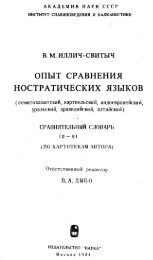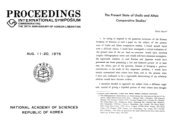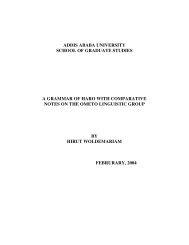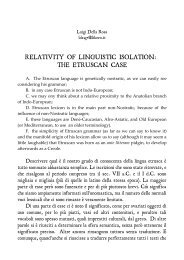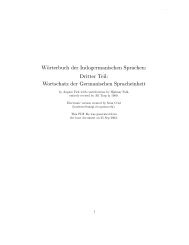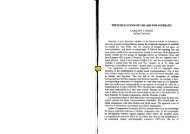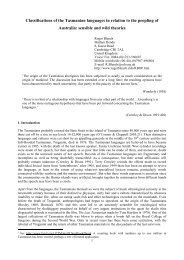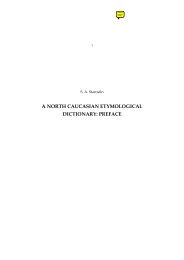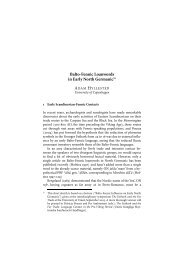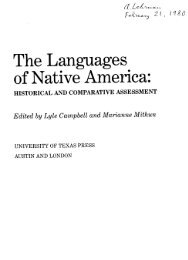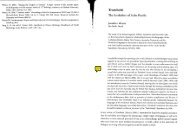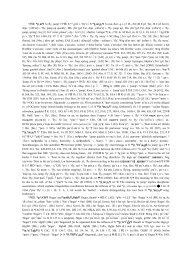The Indo-European Elements in Hurrian
The Indo-European Elements in Hurrian
The Indo-European Elements in Hurrian
You also want an ePaper? Increase the reach of your titles
YUMPU automatically turns print PDFs into web optimized ePapers that Google loves.
14 2. Phonology, Writ<strong>in</strong>g Systems, Texts<br />
also an <strong>in</strong>stance of Õ <strong>in</strong> the obscure word or syntagm [t z Õ r p n m]. <strong>The</strong> presence of */"/ seems<br />
probable, but it must be noted that there is also the case of Šauška [t w t k], with no aleph.<br />
Speiser (1941:19) dismisses the evidence of < d Te-eš-šu-ub-"a-ri> (VS VII 72.10) and of <br />
Mit. IV 50, which he proposes to <strong>in</strong>terpret as *[aje]. We will show below that this is most<br />
probably *[ā"ī"ī]. <strong>The</strong> comparison of Arip-atal with Arip-¯uppi <strong>in</strong> Gelb (1944:114) is also a<br />
powerful clue that a glottal stop prevents the connection between p and the next (")a.<br />
As regards gem<strong>in</strong>ates, [nn] is attested <strong>in</strong> Ugaritic script for the plural article . <strong>The</strong><br />
graphic gem<strong>in</strong>ates and result<strong>in</strong>g from the assimilation of -r- and -l- with the s<strong>in</strong>gular<br />
article -ni are most probably phonetic gem<strong>in</strong>ates. <strong>The</strong> case of the Absolutive plural may<br />
not be a gem<strong>in</strong>ate but a voiceless fricative. As for , the case of suni and summi ‘hand’<br />
suggests that summi is sun=mi with assimilation to the suffix -mi. This is most probably a<br />
phonetic gem<strong>in</strong>ate. As noted above, graphic gem<strong>in</strong>ation is a device to <strong>in</strong>dicate voicelessness, but<br />
it is possible that, <strong>in</strong> some cases, morpheme boundaries resulted <strong>in</strong> phonetic gem<strong>in</strong>ates. Potential<br />
examples are: (1) -ittu, -itta ‘P3 pl. + future’, which can be analyzed as *-id=ta, *-id=tu; (2) -tta<br />
‘P1sg. + Abs.’, which can be analyzed as *-t=wa. Phonetic gem<strong>in</strong>ation appears only at<br />
morpheme boundaries.<br />
On this basis, we would propose the follow<strong>in</strong>g phonological system for <strong>Hurrian</strong>:<br />
Labial Dental Affricate Palatal Liquids Velar Glottal<br />
Voiced /b/ /d/ /m/ /ź/ /l/ /ll/ /g/<br />
Voiceless /p/ /t/ /ˆ/ /ś/ /k/ /"/<br />
Voiced /z/ /r/ /rr/ /γ/<br />
Voiceless /s/ /x/<br />
Nasals /m/ /n/ /nn/<br />
Glides /w/ /y/<br />
A f<strong>in</strong>al remark on the consonants is the tendency of <strong>Hurrian</strong> “laryngeals” (/γ/, /x/ and /"/)<br />
to mute out. <strong>The</strong> word ‘Egypt’ is attested <strong>in</strong> the Mitanni letter as Mit. II 69<br />
and Mit. II 71, which suggests *[ma:sri"a"] with two different treatments<br />
of the f<strong>in</strong>al glottal stop: vowel lengthen<strong>in</strong>g or gem<strong>in</strong>ation. <strong>The</strong> word šu¯uri ‘life’ is also attested<br />
with writ<strong>in</strong>gs like or *[suwri] with no .<br />
Laroche assumes that <strong>Hurrian</strong> had the follow<strong>in</strong>g vowels: /i/, /a/, /u/; he does not exclude<br />
that /e/ and /o/ may have existed, but none of the writ<strong>in</strong>g systems used for <strong>Hurrian</strong> can provide<br />
any support for the existence of /e/ and /o/. It is well-known that the cuneiform system is not far<br />
from be<strong>in</strong>g hopelessly unable to denote this dist<strong>in</strong>ction, even where it may have existed. It can<br />
be noted that tan ‘to do’ (< *dheH÷-) and taše ‘gift’ (< *doHú-) are both written with -a-.<br />
This triangular system /i/, /a/, /u/ is typologically frequent. Apparently, as shown by the<br />
Hebrew and Greek rendition of the word ¯urru¯e ‘<strong>Hurrian</strong>’, the phoneme */u/ <strong>in</strong> <strong>Hurrian</strong> must<br />
have been rather open and sounded like *[o]. As regards the phoneme */a/, it seems to be fairly<br />
anterior and close to *[æ/ε]. An <strong>in</strong>stance of stand<strong>in</strong>g for is šarri ‘k<strong>in</strong>g’ and šerri, šerši



